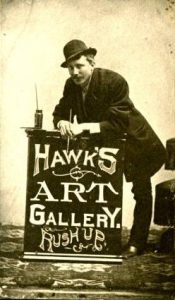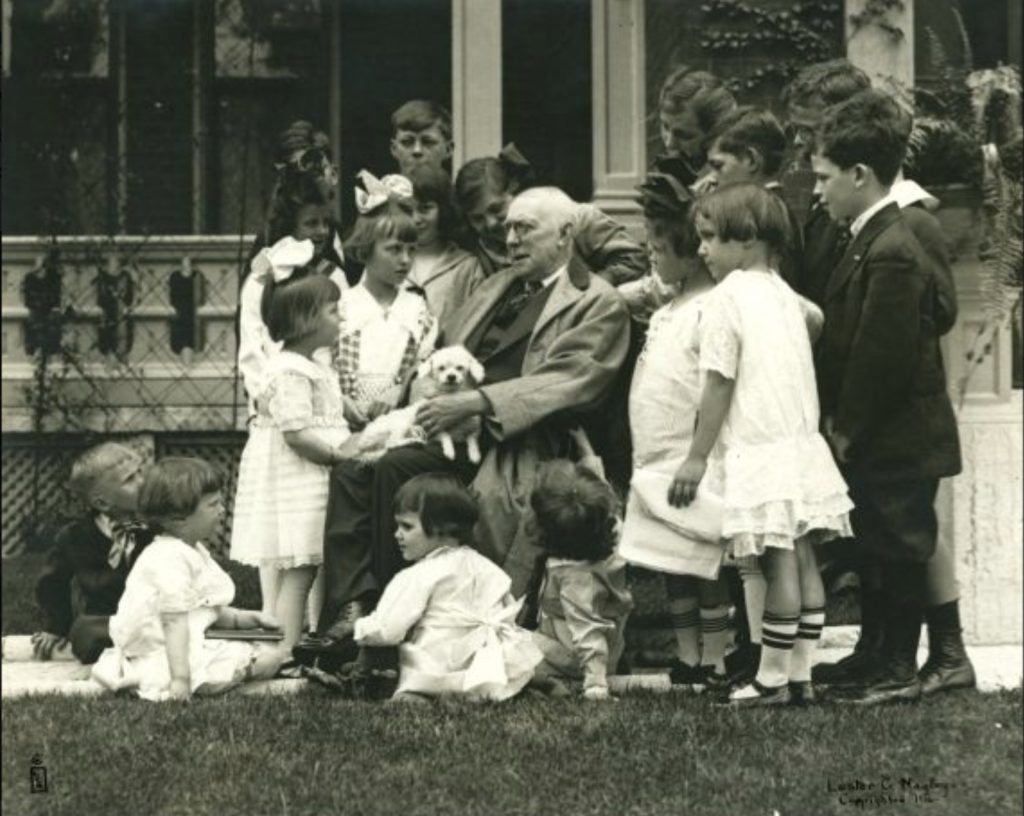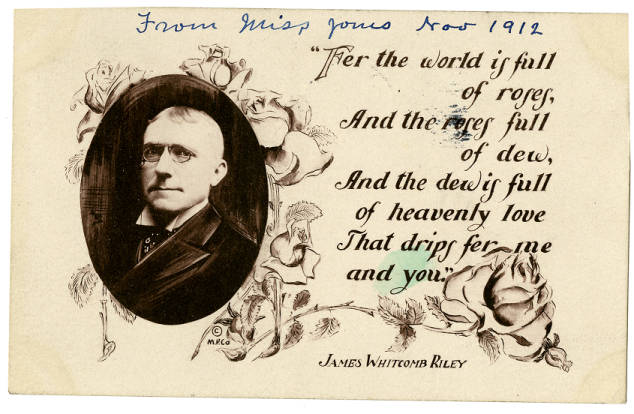
Photo info ...
Credit: Indianapolis-Marion County Public Library Riley Collection, 1835-1960, Indiana Historical SocietyView Source
(Oct. 7, 1849-July 22, 1916). Born in the small town of Greenfield, Indiana, Riley was once regarded as America’s most-loved poet. He remains best known for such poems as “When the Frost is on the Punkin” and “Little Orphant Annie.”

Riley experienced fame and fortune as few writers do in their lifetimes because he provided messages that endeared him to a wide range of Americans in the late-19th and early-20th centuries. His unprecedented popularity as a poet led many critics and authors to believe that Riley would forever be recognized as a major figure in American literature. Although his status in the literary canon has dwindled, Riley’s writing, which expresses the “local color” of the region, holds a particularly special place for Hoosiers.
Riley explored several possibilities before settling on becoming a poet. He briefly studied law in the office of his father, Reuben, who was a prominent Greenfield attorney. He worked as a shoe clerk, a house painter, a Bible salesman, a patent-medicine-show performer, and an itinerant sign painter. His activities as an itinerant performer and sign painter are held up as examples of how old traditions of advertising operated before more commercial forms completely took over the marketing of goods and services.
With the encouragement of the poet Henry Wadsworth Longfellow, Riley left sign painting behind. He worked briefly as a local newspaper editor in Kokomo, Indiana, and later was employed by the . He also began performing on the lecture circuit. In 1887, his performance at a lecture to benefit the International Copyright League in New York City brought him national fame. The combination of his book sales and his lecture fees made Riley the wealthiest working poet in America. Only a few authors, such as Mark Twain, earned more.
Riley’s popularity never waned in the 19th century. His poems were read more than those written by any other nineteenth-century American poet, and his readings packed theaters from coast to coast. The management of his name and image anticipated the way celebrity would be handled in the twentieth century. His bespectacled face was caricatured in magazines and newspapers. Manufacturers used his image to promote their products.

Riley also held a high status in the world of arts and letters. He became friends with some of the leading literary figures of his age, met internationally known artists and statesmen, and performed for presidents in the White House. He received honorary degrees from major universities. In 1908, the National Institute for Arts and Letters elected him to its membership, and in 1912 the National Academy of Arts and Letters conferred on him its medal for poetry. U.S. Secretary of the Interior Franklin K. Lane called for the national observance of Riley’s birthday in 1915.
Although his image has faded, Riley’s legacy remains important to children. Because he wanted to make sure that all children in Indianapolis had free access to books, he made a gift of property at the northwest corner of St. Clair and Pennsylvania streets for construction of a new building for the . After his death, a group of Riley’s friends organized to establish a memorial in his name. The James Whitcomb Riley Memorial Association, later known as the (RCF), built , which is part of . RCF also created Camp Riley for Youth with Physical Disabilities at .
Riley’s contemporaries believed that his depictions of his native state were truthful, but the Indiana countryside of his verse does not reflect broader national patterns of societal change. The state he described was not real. The emotional range of his poetry is rather narrow, and he failed to address issues of any social gravity. Yet some believe that Riley is underrated. “Good readers who emotionally respond to ink on paper can do me a favor… by reading at least one poem by James Whitcomb Riley,” author and Indianapolis native said in January 2007. “If they do, they’ll realize what a good poet he was. And I’ll be so grateful.”
The Hoosier Poet is buried at the highest point in .

Help improve this entry
Contribute information, offer corrections, suggest images.
You can also recommend new entries related to this topic.